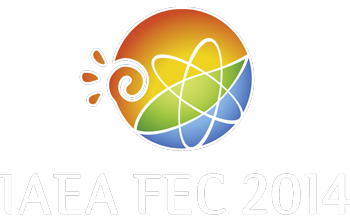Speaker
Dr
Brett Chapman
(USA)
Description
This overview of results from the MST reversed field pinch program summarizes physics important for the advancement of the RFP as well as for improved understanding of toroidal magnetic confinement in general. Topics include energetic particle effects, 3D helical equilibria, beta and density limit studies, microturbulence, ion heating, and magnetic self-organization physics. With neutral beam injection, several bursty energetic particle (EP) modes are observed. The profiles of the magnetic and density fluctuations associated with these EP-modes are measured using an FIR interferometer-polarimeter. Equilibrium reconstructions of the quasi-single-helicity 3D helical state are provided by the V3FIT code that now incorporates several of MST’s advanced diagnostics. A predator-prey theoretical model based on sheared flow and/or magnetic field has been developed that captures key QSH dynamics. Upgraded pellet injection permits study of density and beta limits over MST’s full range of operation, and an MST-record line-average density of 0.9E20 / m^3 (n/n_G =1.4) has been obtained. Plasma beta exhibits saturation at beta_tot ≤ 20% for a wide range of density, 0.2 < n/n_G < 1.6. Gyrokinetic simulations (GENE) based on experimental toroidal equilibrium reconstructions predict unstable trapped electron modes. Nonlinear simulations show that the “Dimits shift” is large and persists at finite beta. Experimentally, small-scale density fluctuations are detected in improved confinement plasmas. Impurity ion temperature measurements reveal a charge-to-mass-ratio dependence in the rapid heating that occurs during a sawtooth crash. Also, a toroidal asymmetry in the ion temperature is measured, correlated with 3D magnetic structure associated with tearing modes. Magnetic self-organization studies include measurements and modeling of the dynamo emf in standard RFP operation as well as with an applied ac inductive electric field to investigate the dynamics of oscillating field current drive (OFCD). Extended MHD computation for standard RFP conditions using NIMROD predicts dynamical coupling of current and plasma flow relaxation. The dynamo emf has also been measured when OFCD is applied, strengthening the understanding of and possibility for steady-state current sustainment using inductive current drive.
| Country or International Organisation | USA |
|---|---|
| Paper Number | OV/5-3 |
Author
Prof.
John Sarff
(University of Wisconsin-Madison)

